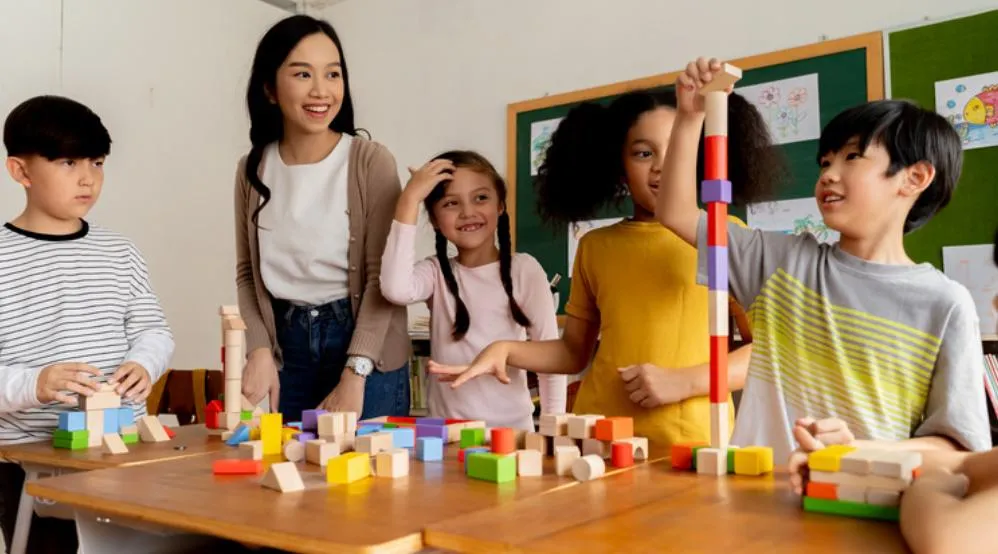
Ultimate Guide to Classroom Management: Build Rapport and Foster Community

Use this link to watch the YOUTUBE version of this post.
Welcome to our summer series of Classroom Management by Design for the Primary Teachers. Each week we will give you a new piece to the classroom management puzzle to have in place when you head back to school this fall. Think of it as a Lego kit just waiting to be built.
Classroom Management by Design for Primary Teachers - Week 5:
Ultimate Guide to Classroom Management: Build Rapport and Foster Communitty
As a master teacher with 20 years of experience, I've discovered that fostering a positive classroom community is paramount for effective classroom management. Building rapport with students, promoting a sense of belonging, and engaging in community-building activities are essential steps in creating an environment where every student feels valued and engaged. In this blog post, I will delve deeper into strategies for building rapport, share innovative activities to promote a sense of belonging, and provide a comprehensive guide to planning community-building activities. These techniques will help you cultivate a supportive and inclusive classroom environment that enhances student engagement and learning outcomes.

Phase 1: Strategies for Building Rapport
Understanding the Importance of Rapport
Building rapport with students is foundational to creating a positive classroom community. When students feel connected to their teacher and peers, they are more likely to be engaged, motivated, and respectful. Rapport fosters trust, communication, and a sense of security, which are crucial for effective learning and classroom management.
Key Strategies for Building Rapport
Personal Connection:
- Beyond just learning names, take time to understand each student's background, interests, and experiences.
- Example: Start a "Student of the Week" spotlight where you highlight a different student each week, sharing their interests, hobbies, and unique qualities.
Active Listening:
- Practice active listening by making eye contact, nodding, and responding thoughtfully to students' comments and questions.
- Example: During classroom discussions, make a point to paraphrase and reflect on students' contributions to show that you value their input.
Consistent Check-Ins:
- Regularly check in with students about their well-being and academic progress.
- Example: Set aside time for short, individual conferences with students to discuss their goals, concerns, and achievements.
Shared Experiences:
- Create shared experiences that build a sense of community and connection.
- Example: Organize classroom traditions like a monthly book club or a weekly "Show and Tell" session.
Transparent Communication:
- Be transparent with students about classroom decisions and changes.
-Example: When introducing new rules or procedures, explain the reasoning behind them and how they benefit the class.

Phase 2: Activities to Promote a Sense of Belonging
Creating a Welcoming Environment
A sense of belonging is essential for students to feel valued and included in the classroom. When students feel they belong, they are more likely to participate, collaborate, and support one another. Here are some innovative activities to promote a sense of belonging in your classroom:
Inclusive Morning Meetings:
- Start each day with a morning meeting that includes greetings, sharing, and group activities.
- Example: Incorporate a "Good News" segment where students can share positive events or accomplishments in their lives.
Cultural Celebrations:
- Celebrate the diverse backgrounds and cultures of your students through inclusive activities and discussions.
- Example: Create a "Cultural Calendar" where students mark and share holidays and traditions from their cultures.
Buddy System:
- Implement a buddy system where students are paired with a classmate for support and collaboration.
- Example: Pair students for activities and projects, rotating partners regularly to foster new connections.
Classroom Jobs:
- Assign classroom jobs that give students responsibility and a sense of ownership.
- Example: Create a job chart with roles like "Classroom Librarian," "Tech Assistant," and "Garden Keeper," allowing students to take on meaningful tasks.
Affirmation Station:
- Set up an "Affirmation Station" where students can leave positive notes and compliments for their peers.
- Example: Provide sticky notes and encourage students to write affirmations for each other, creating a wall of positivity.

Phase 3: Activity: Plan Community-Building Activities
Step-by-Step Guide to Planning Community-Building Activities
Planning community-building activities requires thoughtful preparation and a focus on inclusivity and engagement. Here is a step-by-step guide to help you plan effective community-building activities for your classroom:
Identify Objectives:
- Determine the objectives of the activity. What do you want to achieve? Consider goals such as building trust, fostering teamwork, or celebrating diversity.
- Example: If your goal is to build trust, choose activities that require cooperation and communication.
Choose Appropriate Activities:
- Select activities that are suitable for the age group and interests of your students. Ensure that the activities are inclusive and accessible to all students.
-Example: For younger students, choose simple, hands-on activities like a classroom scavenger hunt.
Prepare Materials and Instructions:
- Gather all necessary materials and prepare clear, step-by-step instructions for the activity.
- Example: For a group art project, prepare art supplies and provide guidelines on how to work collaboratively.
Set Clear Expectations:
- Explain the purpose of the activity and set clear expectations for behavior and participation.
- Example: Before starting a team-building game, discuss the importance of cooperation and respect.
Facilitate and Support:
- Actively facilitate the activity, offering support and guidance as needed. Encourage positive interactions and participation from all students.
- Example: During a group discussion, prompt quieter students to share their thoughts and ensure everyone has a chance to speak.
Reflect and Debrief:
- After the activity, hold a reflection session to discuss what went well, what could be improved, and how students felt about the experience.
-Example: After a collaborative project, ask students to share their thoughts on teamwork and what they learned about their classmates.

Innovative Community-Building Activities
Classroom Quilt:
- Have each student design a quilt square that represents them. Sew the squares together to create a classroom quilt that symbolizes unity and diversity.
-Example: Use fabric markers and fabric squares, and display the quilt prominently in the classroom.
Time Capsule:
- Create a classroom time capsule where students can include letters to their future selves, drawings, and small mementos. Open it at the end of the school year.
- Example: Provide guidelines for what students can include and plan a special ceremony for opening the capsule.
Kindness Challenge:
- Launch a kindness challenge where students perform acts of kindness for their classmates. Track the acts of kindness on a bulletin board.
- Example: Provide a list of suggested acts of kindness and celebrate students' efforts regularly.
Talent Show:
- Organize a classroom talent show where students can showcase their unique talents and interests. This activity fosters appreciation for each other's abilities.
- Example: Create a sign-up sheet for acts and plan a special event where students perform for their classmates.
Story Circles:
- Implement story circles where students take turns sharing stories from their lives. This activity builds empathy and understanding among classmates.
- Example: Set guidelines for respectful listening and sharing, and encourage students to ask questions and give positive feedback.

Conclusion
Fostering a positive classroom community is essential for achieving classroom management success. By building rapport, promoting a sense of belonging, and engaging in innovative community-building activities, you create an environment where students feel valued, respected, and motivated to learn.
Remember, the key to a positive classroom community lies in your commitment to understanding and connecting with your students. Regularly engage in activities that build trust, celebrate diversity, and encourage collaboration. By doing so, you'll not only enhance classroom management but also create a supportive and inclusive learning environment where every student can thrive.
Incorporate these strategies and activities into your teaching practice, and watch as your classroom transforms into a cohesive and dynamic community, ready for success. With a focus on rapport, belonging, and community, you can achieve classroom management success and create a thriving educational environment for all your students.
